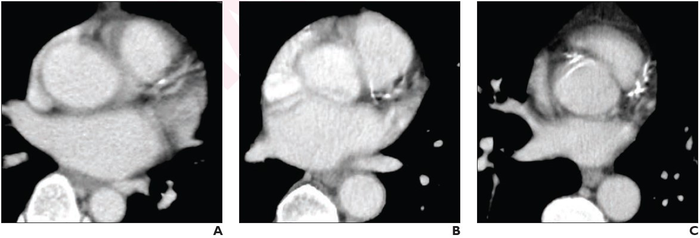Leesburg, VA, April 26, 2022—According to ARRS’ American Journal of Roentgenology (AJR), routine visual ordinal coronary artery calcium (CAC) assessment on all chest CT examinations could identify a large number of patients who might benefit from preventive therapies.

Credit: American Roentgen Ray Society (ARRS), American Journal of Roentgenology (AJR)
Leesburg, VA, April 26, 2022—According to ARRS’ American Journal of Roentgenology (AJR), routine visual ordinal coronary artery calcium (CAC) assessment on all chest CT examinations could identify a large number of patients who might benefit from preventive therapies.
“Visual ordinal CAC assessment on both contrast-enhanced and non-contrast chest CT has high diagnostic performance, prognostic utility, and interobserver agreement,” confirmed corresponding author Kate Hanneman, MD, MPH, from Toronto General Hospital, University Health Network in Ontario.
Hanneman and colleagues’ retrospective study included 260 patients (mean age, 60; 158 male, 102 female) who underwent both non-gated chest CT (contrast-enhanced in 116 patients; non-contrast in 144 patients) and cardiac calcium-score CT within a 12-month interval. A cardiothoracic radiologist visually assessed CAC on chest CT using an ordinal scale: absent, mild, moderate, or severe.
Ultimately, visual ordinal assessment of coronary artery calcium on both contrast-enhanced and non-contrast non-gated chest CT has high sensitivity (83% vs 90%, p=.20) and specificity (100% vs 100%, p=.99), prognostic utility (HR 4.5, p=.02 and HR 3.4, p=.003, respectively), and excellent interobserver agreement (κ=0.89 and κ=0.95, respectively).
“Routine reporting of CAC on all chest CT examinations regardless of clinical indication and contrast material administration could identify a large number of patients with previously unknown CAC who might benefit from preventive treatment,” Dr. Hanneman added.
North America’s first radiological society, the American Roentgen Ray Society (ARRS) remains dedicated to the advancement of medicine through the profession of medical imaging and its allied sciences. An international forum for progress in radiology since the discovery of the x-ray, ARRS maintains its mission of improving health through a community committed to advancing knowledge and skills with the world’s longest continuously published radiology journal—American Journal of Roentgenology—the ARRS Annual Meeting, InPractice magazine, topical symposia, myriad multimedia educational materials, as well as awarding scholarships via The Roentgen Fund®.
Journal
American Journal of Roentgenology
DOI
10.2214/AJR.22.27664
Method of Research
Observational study
Subject of Research
People
Article Title
Visual ordinal scoring of coronary artery calcium on contrast-enhanced and non-contrast chest CT: A retrospective study of diagnostic performance and prognostic utility
Article Publication Date
27-Apr-2022
COI Statement
There are no potential conflicts of interest to disclose.




